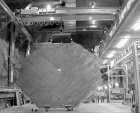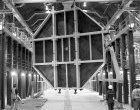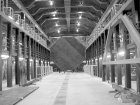 |
|
Fermilab 2002: The Outlook by Judy Jackson
If we learned anything from the year 2001, it is the impossibility of predicting what the next twelve months will bring. Nevertheless, at least one thing seems certain: 2002 at Fermilab will see unique scientific opportunities and extraordinary challenges for physics at the energy frontier.
Even before the old year ended, the new one got off to a promising start with the signing of a new five-year Fermilab operating contract, worth an estimated $1.5 billion. Fermilab’s congressman, Speaker of the House Dennis Hastert, attended the December 27 ceremony where the Department of Energy’s Marvin Gunn and Universities Research Association President Fred Bernthal signed their names to the document that will extend URA’s 36-year operation of Fermilab.
“Fermilab is one of the premier physics laboratories not just in the United States but certainly the world,” Hastert said. “To be able to have a five-year contract and say you know that your future is secure and the science we build on is going to happen here is a good thing.”
Not everyone is on intimate terms with the quarks, Hastert said. “You don’t have to know every little thing that happens here, but you know that great ideas come out of here.”
Meanwhile, the great idea in the Main Control Room, Operations Central for Fermilab’s accelerators, is to rev up the Tevatron to its best possible performance for Collider Run II.
“Our highest priority for 2002 is to get going on the physics operation for Collider Run IIa and to get the luminosity up,” said Fermilab Director Michael Witherell. “We will be doing whatever it takes to deliver the maximum possible number of collisions to experiments.”
“All the accelerator hardware for Run IIa is installed,” Holmes said. “ The Beams Division has plans in place to raise luminosity to the levels we want by year’s end. Our greatest current challenge is to sharply increase our efficiency in transferring antiprotons from the Antiproton Source to the collider. We are devoting five accelerator shifts per week to Tevatron studies to get the luminosity where we want it. Nothing at Fermilab is more important than this. We have to succeed.”
Holmes gets no argument from the Tevatron’s customers, the experiment collaborations at CDF and DZero.
“DZero is looking forward to 2002 because this will be the year that the Run II physics program begins,” said DZero cospokesman John Womersley. “We still have some detector work to do, but we’re hoping that the accelerator makes life hard for us by steadily increasing the luminosity delivered. In 2002, we will present our first physics results; and the first students who have worked on Run II will receive their Ph.D.s.”
Across the accelerator ring at CDF, cospokesman Al Goshaw described 2002 as an exciting year for his collaboration.
“The CDF detector will be recording physics-quality data for the first time since we turned off Run I operation on February 20, 1996,” Goshaw said.
“It has been a long dry spell,” CDF cospokesman Franco Bedeschi agreed, “but the Tevatron program will soon resume a leadership role in experimental high energy physics using the first significant Run II data sample. This really is the beginning of a new era in experimental high energy physics.”
“The year 2002 will be a big one for MiniBooNE,” said spokesperson Janet Conrad. “This spring we will begin taking data. After four years of preparation, it’s very exciting.”
The Neutrinos at the Main Injector project will also reach hard-won milestones in 2002. On December 20, 2001, came the welcome news that the NuMI project has been “rebaselined,” that is the Department of Energy has approved the project’s new cost and schedule, as recommended by a DOE Lehman Review panel in September.
“Rebaselining was a great Christmas present,” said NuMI Project Manager Greg Bock. “This year will be another busy one for NuMI. As we speak, the tunnel boring machine is coming out of the ground. In 2002, we will finish tunneling on the Fermilab site and begin outfitting tunnels and constructing service buildings. Up north, in Soudan, the first supermodule of the MINOS detector will begin taking data from atmospheric neutrinos this summer. We’re truly making progress.”
Fermilab’s long-term future will come one year closer in 2002; and long-range plans will be the subject of a January 28 meeting of the High Energy Physics Advisory Panel. That’s the day HEPAP will make public the report of the Subpanel on Long Range Planning for U.S. High-Energy Physics, the so-called “Bagger-Barish” report, a road map for the field of high-energy physics over the next 20 years. Among its recommendations will be construction of a linear collider “somewhere in the world,” hopefully in the United States, as the next large accelerator for high-energy physics.
“In line with the Subpanel’s recommendations, linear collider work will be getting heightened attention at Fermilab,” Witherell said. “In addition to working on accelerator R&D, we have also formed a linear collider detector working group.”
Fermilab astrophysics projects will be looking up in 2002. The Cryogenic Dark Matter Search will chill down for action in late spring. In Argentina, as successive governments and the peso fell, so did cosmic ray air showers and in December the Auger Observatory observed them for the first time using both fluorescence and surface detectors, which worked precisely according to plan. Auger’s objective in 2002 will be to proceed with full production and deployment of detectors.
The Sloan Digital Sky Survey will scan the sky and measure redshifts for galaxies and quasars at its design peak rate of up to 2500 square degrees and 200,000 spectra per year, providing new statistical leverage in the distribution of matter on cosmological scales, said SDSS spokesman Rich Kron.
“In the search for rare objects, such as spectacularly luminous quasars seen at the greatest look-back times,” Kron said, “it is quite possible that SDSS will break its own redshift record yet again in 2002.”
Security concerns following the September 11 terrorist attacks closed Fermilab’s gates to most of the visiting public. Laboratory officials expressed hope that the easing of such concerns in 2002 will bring neighbors back to the laboratory.
“It’s very important to Fermilab that we maintain the close and friendly relations that we’ve always enjoyed with our neighbors,” Witherell said.
Also ahead in 2002: the home stretch, or at least the almost-home stretch, for Fermilab-led accelerator and detector projects for the Large Hadron Collider at CERN; R&D for the TESLA project; stepped up preparations for Collider Run IIb; extraordinary efforts in computing to deal with the data from Fermilab physics and astrophysics experiments, high-powered new theory applications and the international data grid; ongoing accelerator and magnet R&D; intense efforts on proposed new experiments for Fermilab’s future... The to-do list for 2002 is a long and active one.
And those are just the things we know about.
|
| last modified 1/18/2002 email Fermilab |
FRLsDFx9eyfrPXgV
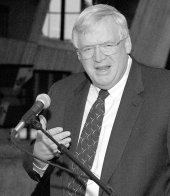 Speaker Hastert used the occasion to describe his pride in the physics laboratory that makes its home in Illinois’s 14th Congressional District.
Speaker Hastert used the occasion to describe his pride in the physics laboratory that makes its home in Illinois’s 14th Congressional District.
 Since restarting after a late-fall shutdown for key accelerator and detector improvements, the Tevatron has been slow to achieve desired levels of luminosity, or proton-antiproton collision rates. Associate Director Steve Holmes described the status of efforts to boost performance.
Since restarting after a late-fall shutdown for key accelerator and detector improvements, the Tevatron has been slow to achieve desired levels of luminosity, or proton-antiproton collision rates. Associate Director Steve Holmes described the status of efforts to boost performance.
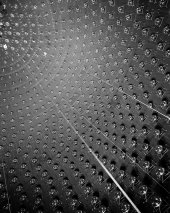 The year ahead also looks like a good one for neutrinos at Fermilab. MiniBooNE will come on the air in late spring. As the experiment’s detector slowly fills with oil and the clock runs toward the start of operations, anticipation builds in the collaboration.
The year ahead also looks like a good one for neutrinos at Fermilab. MiniBooNE will come on the air in late spring. As the experiment’s detector slowly fills with oil and the clock runs toward the start of operations, anticipation builds in the collaboration.

